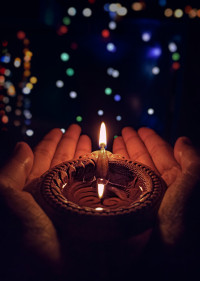As it is
The goddess is not allowed to menstruate
How I got to meet a living goddess and what it taught me about tolerance.
Gina Bachmann
That must be just a tourist thing—is what I thought when a few weeks ago I walked past a sign indicating the home of the living goddess of Patan.
There was a photo on the sign that showed a serious-looking young girl with a colourfully painted forehead, wearing traditional clothes and a lot of jewellery. The idea of this girl being worshipped as a living goddess seemed somewhat absurd to me, and the fact that tourists can pay to get a blessing from her seemed weirder. But I quickly found out that it is a norm in Nepal, at least among the Newar people.
After coming to Nepal on a three-month internship programme, I rented a room from a family in Patan. The family belonged to one of the oldest Newar families and that’s why, once every year, the living goddess of Patan is brought to their house to give all the family members and neighbours a blessing. Kind and welcoming as they are, they had invited me to attend this meaningful religious event. Being blessed by the goddess is believed to bestow prosperity and protection upon its receiver and is viewed as a big honour.
My host brother had explained to me about the living goddess Kumari, which was followed by my own long internet research. From what I was able to gather—each of the Newar cities has its own living goddess. The goddess is selected by various Hindu and Buddhist priests, after she fulfils certain criteria. One of them is for the girl to be as ‘pure’ as possible. A potential living goddess should not have scars or any other injuries and she must come from a high caste. Once selected, the living goddess is not allowed to walk, as that would damage her purity. She has to be carried in a palanquin, and she doesn’t get to leave her home very often. Most of the time, the living goddess’s job is to bless her worshippers.
But the purity criteria has yet another implication: a girl’s life as a Kumari ends with her first menstrual cycle. Then, a new girl is chosen, as it is believed that the divine spirit leaves the Kumari’s body when menstruating. When I first heard this, I was taken aback. In all honesty, this piece of information almost made me hesitant. But just when I brushed off my reservations in favour of understanding a culture that was very different from mine, I was jolted with yet another piece of information—if a woman is on her period, they aren’t allowed to be part of the celebration.
I wasn’t on my period. But I was getting a little upset. Why this period shaming? Why idealise the female body to be ‘pure’ and ‘clean’? During menstruation, the body actually cleans itself from the tissue the uterus builds up to prepare for pregnancy. Excluding women from social and religious activities just because their body does what it is supposed to do seemed so utterly wrong to me that I thought of staying in my room, boycotting the event.
But a knock on my door interrupted my thoughts. “Tsina (This is how my host mum pronounces my name), the Kumari is here. Come, come!” When I opened the door, I saw her beautifully dressed in a red sari, wearing gold and red jewellery, beaming at me and excitedly pointing to the yard.
No way could I have let her down at that moment. I like my host mum way too much, and I realised how much this event meant to her and the family and how excited they were to show me their tradition. So, I followed her to the yard.
The dimly lit yard was full of people. Kids were running around, elderly people were sitting on plastic chairs, some of them half asleep, and there was a neat queue in front of a small room in one of the houses attached to the yard. I lost sight of the family and lined up at the end of the queue. Suddenly my host sister appeared, persuading me to skip the queue and join the family, who were about to get in now.
Despite the many people gathered, the room was very quiet. The Kumari was sitting on a few cushions, and looked exactly like the photo I had seen a few weeks before. One after the other, people kneeled and bowed to her with their hands put together in front of their chest—out of respect for the living goddess. In a routined way, the Kumari put tika on their foreheads, stifling a yawn from time to time. She didn’t smile or talk. It was stunning, and at the same time, bewildering to see a six-year-old girl carrying out her duty in such a serious and prudent way.
Eventually, it was my turn to meet the Kumari. I was a little nervous now, but more because of everybody else’s excitement and because I feared I could somehow offend people. I knelt down, bowed to her and felt her soft finger touching my forehead. I didn’t feel any special energy coming from her but it felt very nice to be given the blessing and to be part of that ceremony. Somehow it gave me a feeling of belonging and protection.
I still think the obsession with the purity of the female body, which is evident with the practice of Kumari, is problematic. Even in rural areas of Nepal, the practice of chhaupadi banishes menstruating women and girls from the family house, forcing them to stay alone in a shed, even at night. While this phenomenon might slowly be losing its relevance, nachhune, the exclusion of women and girls on their period from religious ceremonies and kitchen activities is still widespread.
However, period shaming happens all across the world and in many different settings. Talking about my personal experiences, in Switzerland, we would rather excuse ourselves by mumbling something about a headache instead of talking about period cramps. In offices or public spaces, women suddenly behave like professional drug dealers when passing over a pad or tampon to a friend. And if it was too much for the audience to cope with the fact that blood is red, TV ads usually use a weird bluish liquid to demonstrate the purpose of a sanitary pad.
When I first learned about the Kumari, I knew I could go on criticising this obsession over ‘purity’. But on a personal level, this story ends with a lesson on tolerance. My host family follows this practice and being their guest at this ceremony I didn’t feel entitled to judge. That’s not the reason why I came to Nepal. I came here to observe and learn.




 9.12°C Kathmandu
9.12°C Kathmandu








%20(1).jpg&w=300&height=200)

